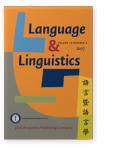Vol. 18:2 (2017) ► pp.228–253
Is it syntactic or pragmatic?
A hybrid analysis for lf-intervention effects
The main aim of this study is to reconsider Tomioka’s (2007) pragmatic account of the lf-intervention effects (IE), and to claim that Polarity Sensitive Items (psis) are genuine syntactic interveners. I will examine the parallelism among psis in IE configurations, which is distinct from other interveners, and further claim that the study of IE should not be monolithic, but hybrid: Syntactic lf-interveners (psis), blocking scopal interactions/Pragmatic interveners, causing illegal information structures. The predictions will be borne out that psis actually cause IE in other contexts as well, which pragmatic accounts cannot explain (Funakoshi & Takahashi 2014). Such hybrid perspectives bring back enormous findings on IE (e.g. lf wh-movement) to the field of syntax, without relegating all of them to pragmatics.
Article outline
- 1.Introduction
- 2.Pragmatic accounts of the intervention effects
- 2.1Cancellation effects by scrambling
- 2.2The root-embedded contrasts
- 2.3Interim conclusion
- 3.Problems of pragmatic accounts of lf-intervention effects
- 3.1Why are npis different from other interveners?
- 3.2The parallelisms among psis in lf-intervention effects
- 4.Polarity sensitive items as genuine lf-interveners
- 4.1 npis in nominative object constructions
- 4.2 apis and bpis in nominative object constructions
- 4.3Affirmative polarity and bipolar sensitivity as a syntactic phenomena
- 5.Further discussions: neg-raising and apis/bpis under neg
- 6.Conclusion
- Acknowledgements
- Notes
-
References
For any use beyond this license, please contact the publisher at [email protected].
